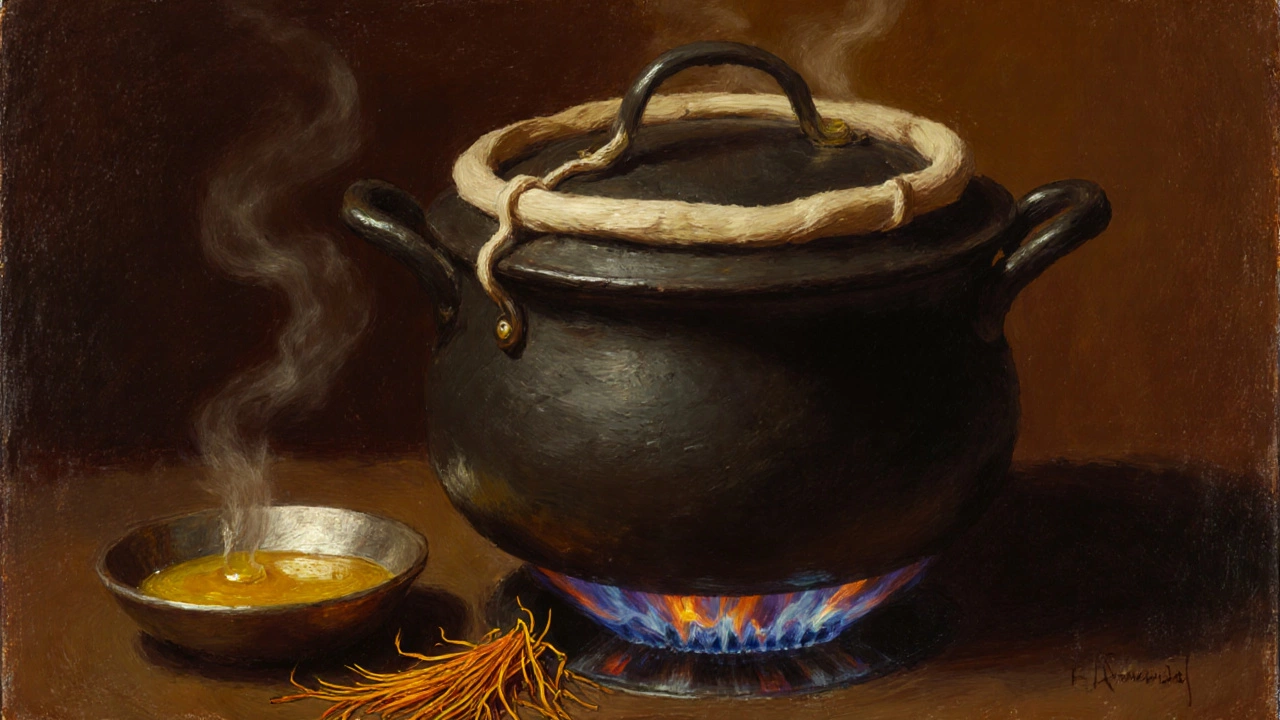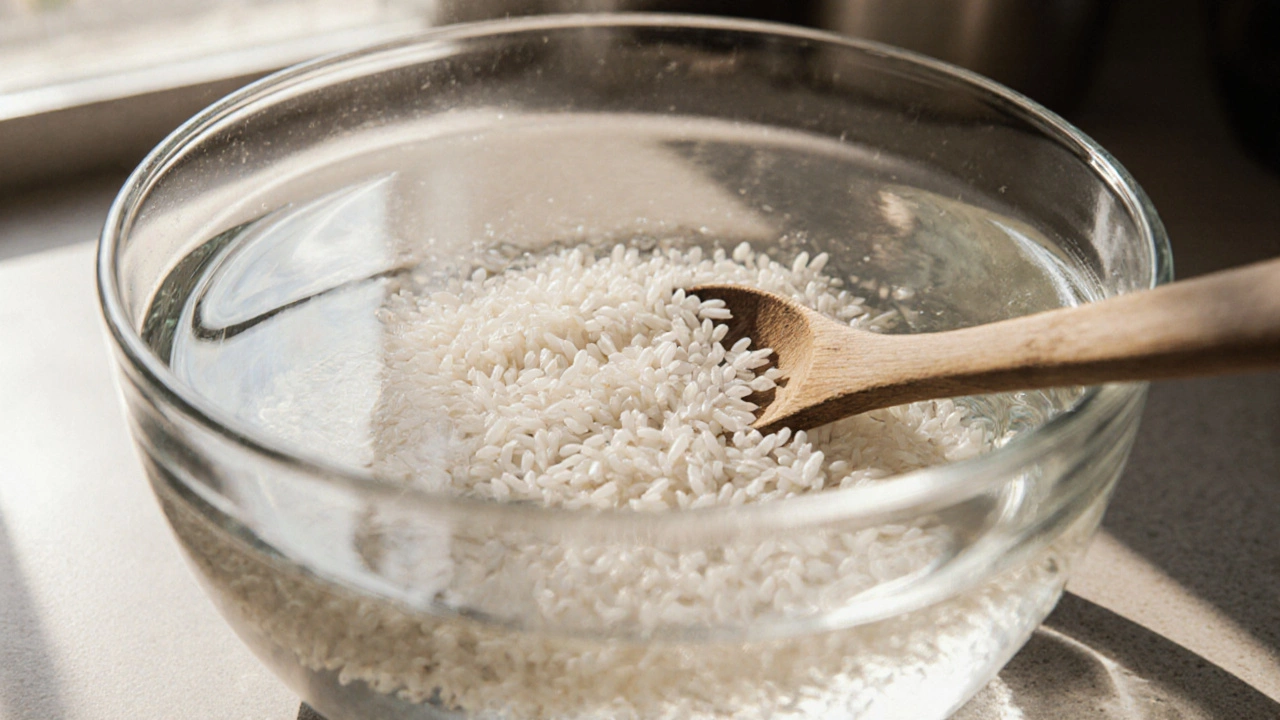Biryani Rice Boiling Time Calculator
Get Your Perfect Biryani Rice Timing
Calculate the exact boiling time for your biryani rice based on method, altitude, and rice age. Always stop at 70% doneness (grain still firm in center).
Enter your cooking details to see precise boiling time.
Getting the rice right is the secret sauce behind a memorable biryani. Too soft, and it turns mushy; too firm, and it stands out like a sore thumb. In this guide we break down exactly how long to boil rice for biryani, why each step matters, and what common pitfalls to dodge.
Why Rice Choice Matters in Biryani
Traditional biryani leans on Basmati rice is a long‑grain aromatic rice grown primarily in the Indian subcontinent. Its slender kernels stay separate when cooked, thanks to a high amylose content and a natural fragrance that bursts with each bite. The grain’s length‑to‑width ratio (about 7:1) gives it a fluffy texture that absorbs the layered spices without disintegrating. Swapping it for a short‑grain or instant rice dramatically changes the mouthfeel, turning a regal dish into a soggy stew.
Step 1 - Soaking: The Unsung Hero
Before the pot even heats up, give the rice a good soak. Soaking does three things:
- It hydrates the outer layer, shortening the actual boil time.
- It allows the grains to expand uniformly, reducing breakage.
- It leaches out excess surface starch that would otherwise make the rice glue together.
For biryani, aim for a Soaking period of 30 minutes to 1 hour in cold water. If you’re in a hurry, a 15‑minute soak works, but expect a few extra seconds on the boil.
Step 2 - Nailing the Water‑to‑Rice Ratio
The classic ratio for biryani rice is 1 cup of dry basmati to 1.5 cups of water. This 1:1.5 proportion is leaner than the usual 1:2 used for plain steamed rice because the grains will finish cooking in the final “dum” phase, absorbing steam from the meat and spices.
Keep a few rules in mind:
- If the rice is older (more than a year), add a tablespoon extra water per cup.
- For high‑altitude cooking (above 3,500 ft), increase water by 10 %.
- When using a pressure cooker, reduce water by 20 % because the sealed environment retains moisture.

Step 3 - Boiling Methods & Exact Timing
Here’s where the biryani rice cooking time comes down to the method you choose. Below is a quick‑reference table that sums up the exact boil minutes for each popular technique.
| Method | Water Amount | Boil Time (seconds) | When to Stop |
|---|---|---|---|
| Stovetop (large pot) | 1.5 × rice | 550‑600 seconds (9‑10 min) | Grains are 70 % cooked (still firm in the center) |
| Pressure cooker (high pressure) | 1.2 × rice | 300‑330 seconds (5‑5½ min) | 70 % done; quick‑release steam |
| Rice cooker (automatic) | 1.5 × rice | Program "White Rice" (≈ 12 min) | Pause when cooker beeps; rice should still have a bite |
Key takeaways:
- Never cook the rice until fully tender. Aim for 70 % doneness because the final "dum" phase will finish the job.
- Stir gently once, just after the water reaches a rolling boil, to prevent sticking.
- When using a pressure cooker, the timer starts once full pressure is reached, not when the lid first clicks.
Step 4 - The Dum Finish: Steaming to Perfection
After draining the partially boiled rice, layer it over the spiced meat or vegetables in a heavy‑bottomed pot. Add a few drops of Ghee clarified butter that adds shine and depth of flavor and a pinch of Saffron soaked in warm milk for color and aroma. Seal the pot tightly (a dough seal works well) and cook on low heat for 20‑25 minutes. This sealed “dum” step lets the rice finish absorbing the steam, spices, and juices, creating that signature fluffy‑yet‑moist texture.
Step 5 - Pro Tips to Nail the Texture Every Time
- Use a heavy‑bottomed pot. Thin pans cause hot spots that can burn the bottom layer.
- Add a teaspoon of Parboiling partial boiling technique that firms up grains before final cooking salt to the boiling water; it seasons the rice from within.
- After the dum phase, let the biryani rest for 10 minutes before opening. This allows the steam to settle and the flavors to meld.
- Fluff the rice gently with a wide‑tined fork; avoid a spoon that can crush the grains.

Common Mistakes and How to Fix Them
Rice turns mushy. Most likely you over‑boiled or used too much water. Drain immediately when the 70 % mark is reached and reduce water in the next attempt.
Grains stick together. Skipping the soaking step leaves excess surface starch. Rinse the rice a couple of times after soaking to wash away leftover starch.
Flat flavor. Biryani lives on layered aromatics. Don’t skip the saffron‑milk mix or the ghee drizzle during the dum stage.
Quick Reference Checklist
- Soak basmati 30‑60 min in cold water.
- Use 1 cup rice : 1.5 cups water (adjust for age/altitude).
- Boil 9‑10 min on stovetop, 5‑5½ min in pressure cooker, or 12 min in rice cooker.
- Stop at 70 % doneness (grain still firm in center).
- Layer with ghee, saffron milk, and spices; seal and dum 20‑25 min.
- Rest 10 min, then fluff gently.
Frequently Asked Questions
How many minutes should I boil basmati rice for biryani?
Aim for 9‑10 minutes on the stovetop, 5‑5½ minutes in a pressure cooker, or use the rice‑cooker’s white‑rice setting (≈ 12 min). Stop when the rice is about 70 % cooked.
Do I need to soak the rice if I’m using a pressure cooker?
Yes. Soaking for at least 30 minutes reduces pressure‑cooking time and helps keep the grains separate.
Can I use instant rice for biryani?
It’s not recommended. Instant rice cooks too soft and won’t hold up during the dum phase, resulting in a mushy biryani.
What’s the purpose of the ‘dum’ step?
‘Dum’ seals the pot so steam circulates, letting the partially boiled rice finish cooking while soaking up the flavors from the meat, spices, ghee, and saffron.
Should I add salt to the boiling water?
A pinch of salt (about ½ tsp per cup of rice) seasons the grains from the inside and improves texture.
